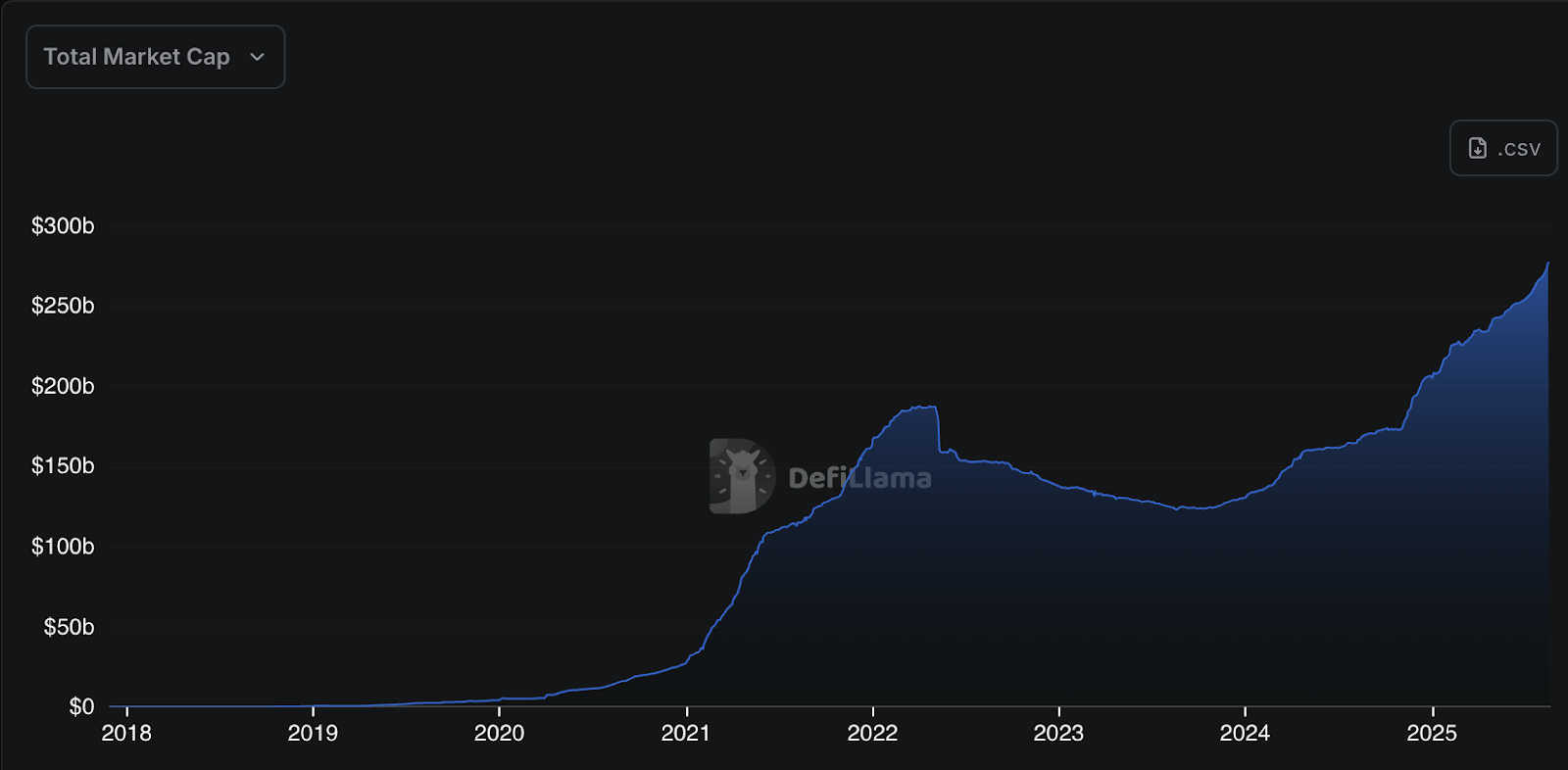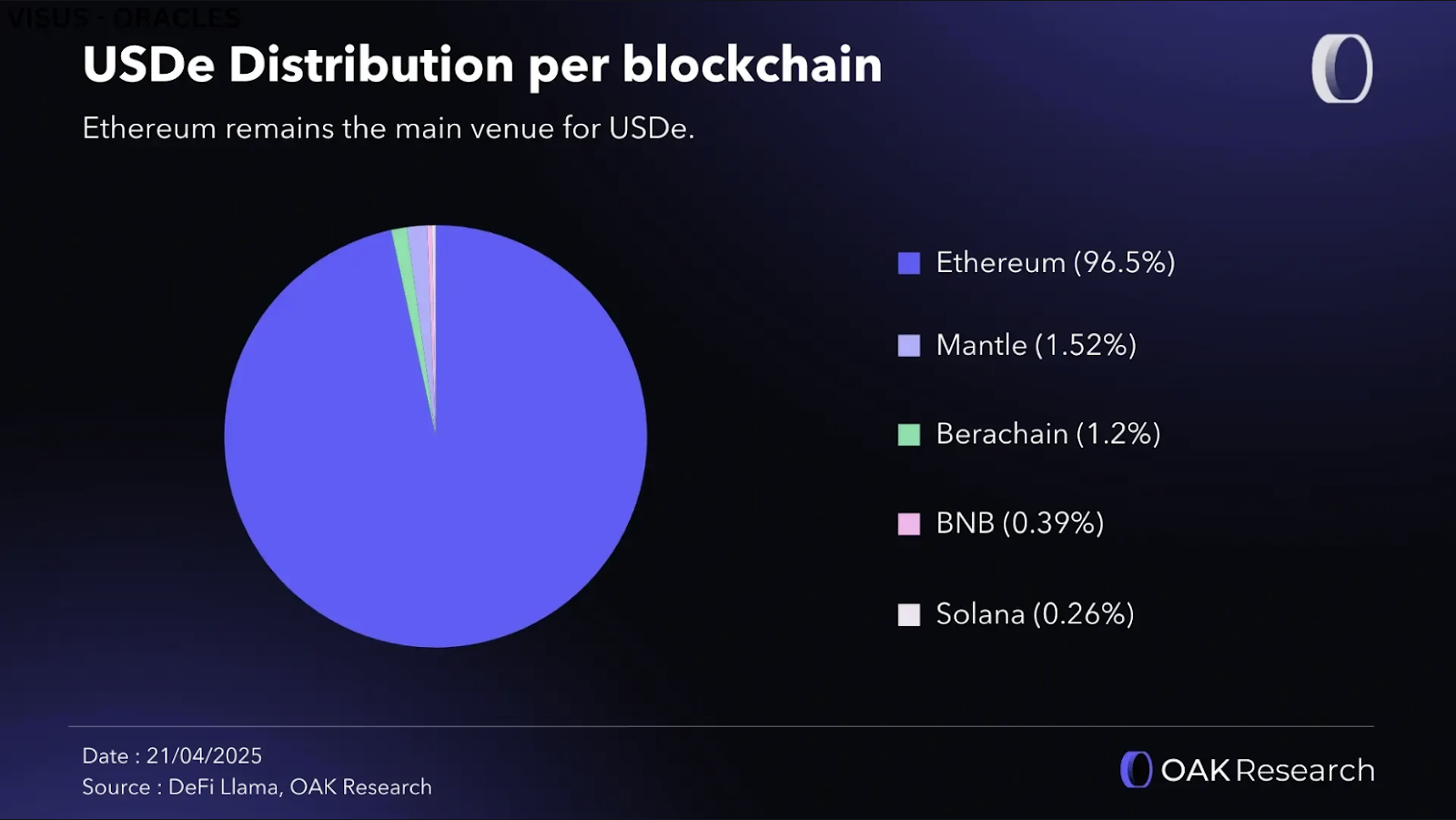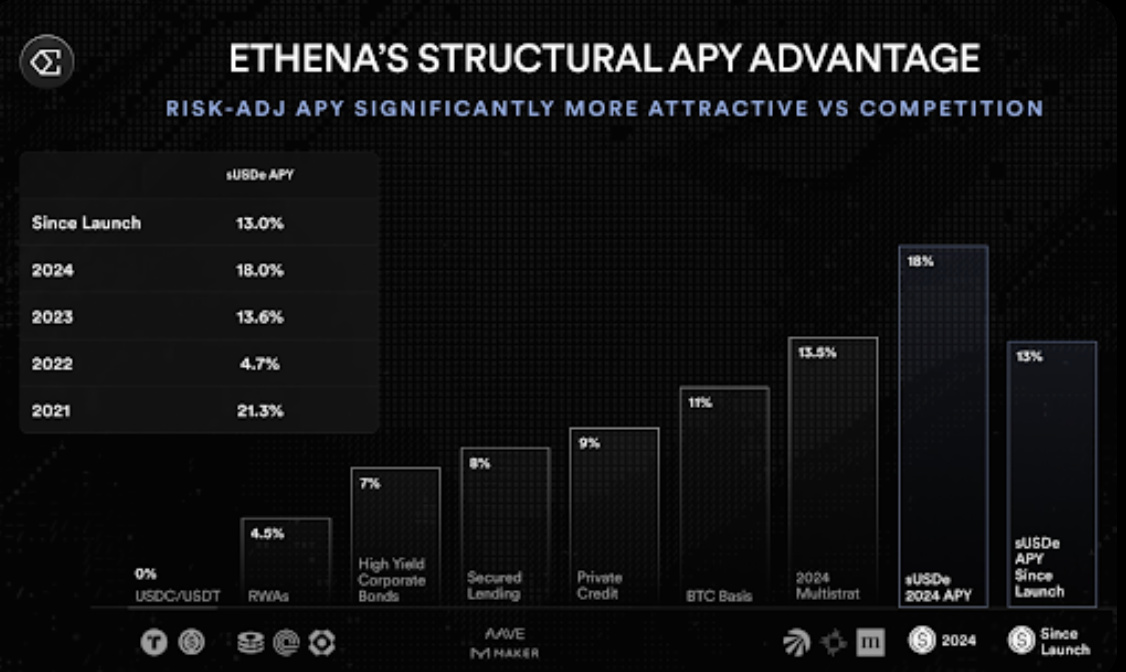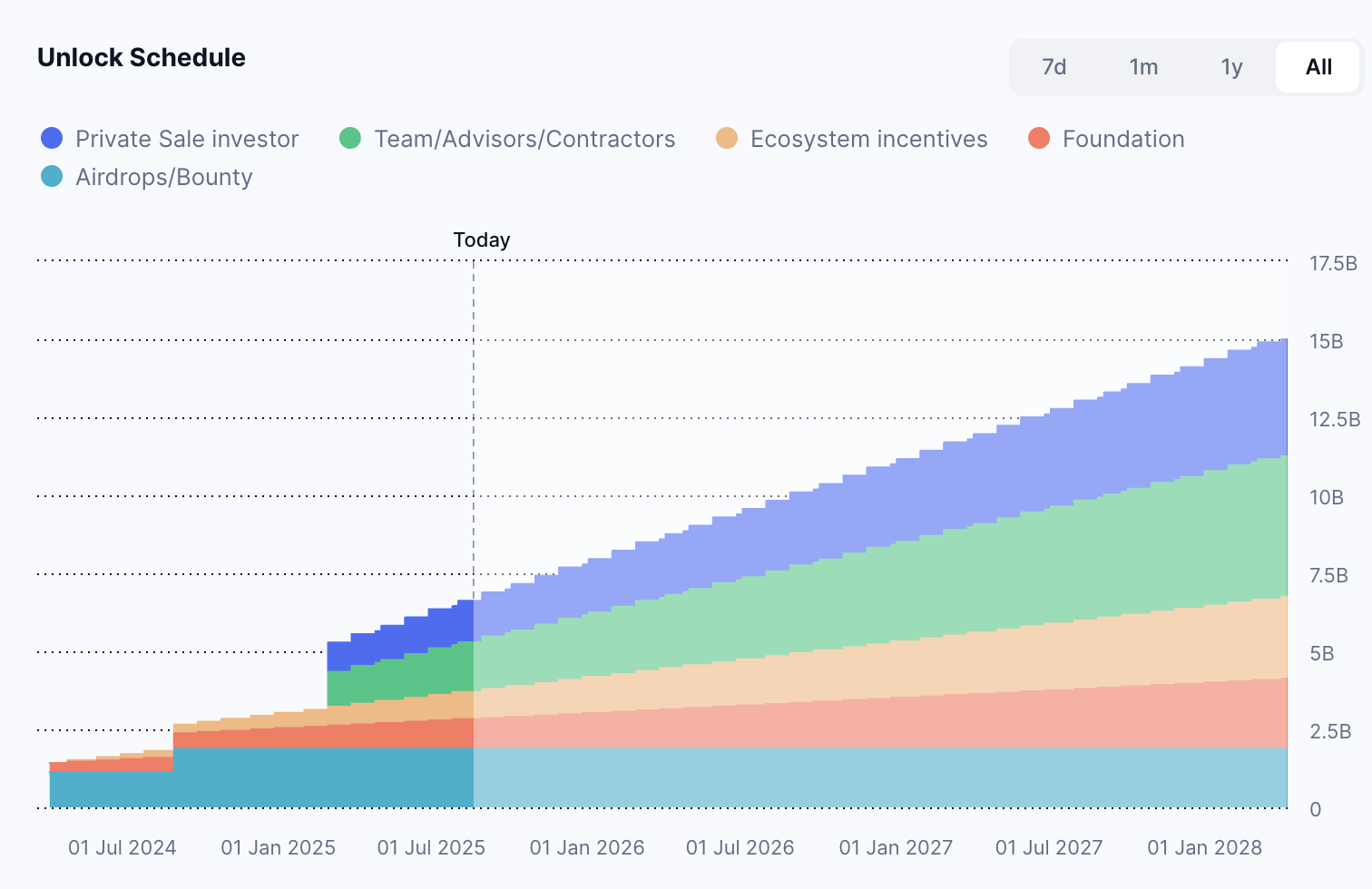ENA is now available for trading on Netcoins.
Ethena has quickly become a standout in the world of crypto, offering innovative yield bearing stablecoins. Powered by its native token ENA, the protocol is designed to make crypto more accessible and rewarding for everyday users while appealing to institutions. In this research report, we'll explore Ethena's mechanics, its place in the broader market, and what it means for investors, doing so in a straightforward way that cuts through the complexity.
The Stablecoin Landscape & The Problems Ethena Solves

Stablecoins have exploded onto the scene as the backbone of defi, enabling traders to have dry powder to buy dips, partake in lending or borrowing against their assets and more. As of August 2025, the total stablecoin market cap has surged past $270 billion, up significantly from earlier years, driven by increased adoption in DeFi trading, remittances, and even institutional portfolios. But the stablecoin world isn't without its headaches. The biggest ones like USDT or USDC, rely heavily on centralized backing via Tether and Circle. This introduces risks: regulatory crackdowns, potential freezes, or even counterparty failures, as we've seen in past crypto winters. On the flip side, purely decentralized options often require over collateralization (locking up more value than you mint), which can be inefficient and prone to liquidation cascades during market dips. Yields? Most standard stables offer little, leaving users missing out on passive income opportunities that crypto promises.
Institutions want compliance and predictability, while retail users crave simplicity and rewards. Ethena steps in here, solving these by creating a suite of stablecoins that use smart hedging for stability, diversified backings for resilience, and built-in yield mechanisms that adapt to market conditions. It's like upgrading from a basic savings account to one that earns interest dynamically, all while reducing some of the centralization pitfalls.
Enter Ethena
Ethena Labs burst into the spotlight with its groundbreaking approach to stablecoins, starting with the launch of USDe: A synthetic dollar that doesn't just sit idle but actively works to maintain stability through clever financial engineering. Ethena has expanded into a multi-product ecosystem, now operating across multiple blockchains like Ethereum, Solana, and others. As of mid-2025, its flagship USDe has grown to over $10 billion in supply, making it the 3rd largest stablecoin on the market. What sets Ethena apart is its focus on decentralization without sacrificing usability. The protocol is permissionless at its core, meaning anyone can interact with it: mint, redeem, or stake it without gatekeepers. It's collaborative by design, integrating seamlessly with other DeFi tools like lending platforms and yield optimizers, allowing users to stack rewards. And it leans on crypto-economic incentives: The native ENA token aligns everyone's interests, rewarding holders who participate in governance and staking.
For retail users, think of Ethena as a user-friendly entry point into advanced crypto finance. You don't need to be a trader to benefit; deposit stable assets, and the protocol handles the hedging behind the scenes. This democratizes access to yields that were once reserved for pros, all while pushing for a more open, global financial system.
How Ethena Works
At its heart, Ethena is a protocol that creates stable value through a combination of collateral backing and delta-neutral hedging. Delta-neutral means the system balances positions to offset price movements. If crypto prices rise or fall, the hedges kick in to keep things steady. This is done on centralized exchanges for efficiency, but with transparency to build trust.
Ethena's strength lies in its diverse stablecoin lineup, each tailored to specific user needs:
USDe: The core product, a synthetic dollar you mint by depositing other stables like USDT or USDC (or even fiat through partners like Alchemy Pay). It's backed by a mix of assets: primarily staked ETH via liquid staking tokens (LSTs like stETH), BTC, SOL, and liquid stables. This blend provides over 100% backing without the overcollateralization drag seen in other protocols. As of now, it's distributed across chains, with Ethereum holding the lion's share at around 96%, followed by smaller portions on Mantle, Berachain, and others. Recent governance votes have added features like SOL backing, enhancing flexibility.

- sUSDe: This is the staked upgrade to USDe, where you lock it to earn rewards. It's built as an ERC-4626 tokenized vault, making it super composable so it can plug into other DeFi apps for extra yields. Rewards accrue every few hours, drawn from the protocol's overall revenues.
- USDTb: Geared toward stability in any market, this one's backed by tokenized U.S. Treasuries held in funds like BlackRock's BUIDL. It's issued through partners like Pallas Ltd for compliance, appealing to institutions seeking predictable, low-vol returns.
- iUSDe: The institutional flavor, essentially a "TradFi-wrapped" version of sUSDe with KYC checks. It's designed for arbitrage between DeFi yields and traditional rates, and it's set to launch on specialized chains like Converge for better accessibility.
In practice, a user might deposit $1,000 in USDT to mint USDe. Ethena then uses that to buy collateral (like ETH or BTC) and opens short positions to hedge, ensuring the value stays pegged to $1. This "meta-network" of products lets users choose based on their risk appetite. Retail folks might stick with USDe for simplicity, while pros leverage iUSDe for cross-market plays.
Ethena’s Yield Generation

Yields are what make Ethena exciting, turning stablecoins from mere value holders into income generators. The protocol pulls this off through a trio of revenue streams that feed into sUSDe holders:
- Staking Collateral: A portion of the backing assets, like ETH in LSTs, earns staking rewards from the underlying networks. This provides a baseline that's relatively steady.
- Funding Rates from Hedging: When Ethena opens short positions on derivatives exchanges, it captures funding rates which are payments from long traders in bull markets. This can boost yields when crypto is pumping but varies with sentiment.
- Interest from Real-World Assets: Via USDTb, T-bill holdings add a layer of predictable income, helping in bear markets where funding might dip.
These revenues are distributed to sUSDe stakers periodically, with a Reserve Fund stepping in to cover any temporary shortfalls (like negative funding periods). Importantly, yields aren't fixed, they fluctuate with market dynamics. Historically, they've been strong in upbeat conditions, but users should expect variability and monitor trends. For example, in volatile times, the mix shifts toward safer assets like Treasuries for resilience. This setup not only rewards holders but also stabilizes the ecosystem by encouraging long-term participation.
The ENA Token Economy

The ENA token is the lifeblood of Ethena, serving as more than just a governance tool, it's the key to unlocking value in the ecosystem. With a fixed total supply and thoughtful vesting schedules, ENA is designed to reward active participants while supporting the protocol's growth. As of August 2025, ENA's market cap hovers around $1.5 billion, with significant portions staked for enhanced benefits.
ENA's utility shines in several ways:
- Governance: Holders vote on crucial decisions, like adding new collateral types (e.g., the recent SOL integration) or protocol upgrades. This gives the community real say in Ethena's direction.
- Staking and Rewards: Stake ENA to earn a share of protocol fees once the "fee switch" activates. This could include revenues from minting, redemptions, or ecosystem integrations.
- Incentives for Participation: Small ENA fees apply to certain actions, like advanced registrations, but these feed back into the system. Plus, ENA powers airdrops and farming programs, such as the Shards system for liquidity providers.
Supply dynamics are straightforward: A portion is circulating for trading, while locked and vested amounts ensure steady releases without dumps. Emissions are tied to adoption, creating a flywheel where more users mean more value accrual to ENA holders. For retail investors, holding ENA is like owning a piece of a growing bank that offers governance perks plus potential upside as the stablecoin suite expands.
Risks and Challenges
No crypto project is risk-free, and Ethena is no exception. Its innovative hedging model brings unique challenges that users should weigh carefully.
Key risks include:
- Funding Rate Volatility: In prolonged bear markets, funding rates can turn negative, potentially reducing yields or straining the Reserve Fund. While the fund (sized at millions per billion in USDe) acts as a buffer, extended periods could test its limits.
- Collateral and Depeg Risks: Backing assets like stETH have historically depegged mildly (up to 8%), which could halt minting or redemptions if extreme. Liquidation thresholds are high (around 65% divergence), but cascades in crypto crashes remain a concern.
- Exchange and Custodial Dependencies: Relying on CEXs for hedging exposes the protocol to platform failures or restrictions: Think FTX-style events. Off-exchange settlements help, but it's not fully decentralized yet.
- Regulatory Hurdles: Products like iUSDe and USDTb aim for compliance, but evolving global regs could impact operations, especially cross-border arbitrage.
Mitigations are built-in: Diversified backings reduce single-asset risks, transparency dashboards let users track everything, and an insurance fund covers shortfalls. Ethena's team has been proactive in addressing these, but as with any DeFi play, DYOR (do your own research) is key.
Competitors and Differentiation
Ethena holds a strong spot in the yield-bearing stablecoin niche. It leads competitors like Sky (formerly MakerDAO's sUSDS and sDAI) and Prisma, thanks to its delta-neutral hedging that provides resilience in both bull and bear markets.
What differentiates Ethena? Its multi-product approach covers retail simplicity (USDe/sUSDe) and institutional needs (USDTb/iUSDe), while deep DeFi integrations with protocols like Pendle and Aave boost composability. Unlike fiat-heavy rivals, Ethena's crypto-native backing captures upside from assets like ETH and BTC, and its fee-sharing model via ENA is a game-changer as no other major stable has this yet.
Weaknesses? Some see the CEX reliance as a centralization point, and unstaking locks can feel restrictive compared to instant-access options. Still, Ethena's liquidity moat is growing, positioning it as a top contender in a market projected to expand rapidly.
Growth Potential and Use Cases
Looking ahead, Ethena's bull case is compelling: Scaling to $100 billion or more in supply as stablecoins go mainstream, fueled by institutional inflows and DeFi booms. With the fee switch looming, ENA could see substantial value accrual, turning it into a "kingmaker" token in the space. Use cases abound include: USDe as collateral for derivatives trading, sUSDe for yield farming, USDTb for safe savings, and iUSDe bridging TradFi arbitrage.
Catalysts include more chain expansions, regulatory tailwinds (like clearer U.S. crypto laws), and integrations with emerging ecosystems. In a bear scenario, negative funding or depegs could slow momentum, but Ethena's diversified revenues make it more adaptable than pure algo stables. For everyday users, Ethena has become the go-to for yield bearing stablecoin and looks to continue its dominance by taking away market share from the two giants ahead of it in USDT & USDC.
The information provided in the blog posts on this platform is for educational purposes only. It is not intended to be financial advice or a recommendation to buy, sell, or hold any cryptocurrency. Always do your own research and consult with a professional financial advisor before making any investment decisions. Cryptocurrency investments carry a high degree of risk, including the risk of total loss. The blog posts on this platform are not investment advice and do not guarantee any returns. Any action you take based on the information on our platform is strictly at your own risk. The content of our blog posts reflects the authors’ opinions based on their personal experiences and research. However, the rapidly changing and volatile nature of the cryptocurrency market means that the information and opinions presented may quickly become outdated or irrelevant. Always verify the current state of the market before making any decisions.



.png)

.png)
.png)




